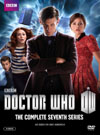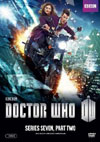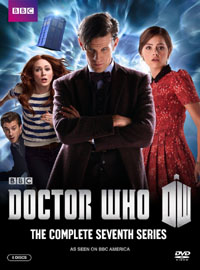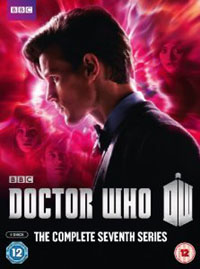(Doctor Who Story No. 241, starring Matt Smith)
|
DVD Extras for this story on the 15-episode box sets include:
Anticipating Jules VerneThe opening sequence displays elements of genius. We get a brilliant first shot of a freighter craft in an area of deep space that is full of colour and interesting phenomena to explore.... What could be better, I ask? This immediately engaged me far better than the previous two stories had with their openings. Finally we were getting back out to where we should be.Next up we got some shots of the crew that indicated that they were working-class androids, telling us immediately that there was some kind of unusual social structure in their culture that would probably be interesting to explore... another plus. Then the Doctor and Clara turn up with a fun scene in the TARDIS console room. And with Clara finally wearing the red dress and hair style in which she appears on the cover of the North American full-season DVD box set, I began to wonder if that might indicate that this was one of the more important, definitive stories of the season. Has Clara moved in yet? I think at this point we can say yes - if ever it happens in this season, it has happened by this point. There is an additional scene called "Clara and the TARDIS" which I believe is best placed just before this story, in which Moffat makes her move-in a little more explicit. Conflict begins as the two locations interact and link-up, with the salvage ship capturing the TARDIS. Anticipation for this story peaks as we get the episode title followed by the CG shots of a mechanical arm bringing the police box in amongst the day's haul. "Journey to the Centre of the TARDIS" is a title that immediately tells you where the story is going, after having a good sequence showing us where the story is starting from - a point that can introduce some excellent external elements and unknowns while also establishing the standard entrance to the vast maze of the TARDIS interior. Plus, the title is so reminiscent of Jules Verne and his famous novel "Journey to the Centre of the Earth" that one immediately hopes that the exploration of the TARDIS interior will be as classically adventurous.
Already BustedWhat sadly follows is sign after sign that logic has completely escaped the makers of this episode. The first jolt comes from seeing the Doctor's feet lying outside the TARDIS, the second that he is up and about outside the machine and chatting up the salvage crew. Why he wasn't still safe and sound inside the machine, leading us viewers through a damage survey before coming out, was a complete mystery to me.A lot of what this familiar character does next seems to have little motivation that can be easily followed. He obviously doesn't trust this crew very far, and keeps one eye on the inconsistencies in their stories the whole time.... so why is he so keen to get them to help him go back into the TARDIS and find Clara? You'd think he would at least try his own key on the door to pop back in first. And surely Clara is still safe and sound inside, most likely in the console room. This story really fails to show that the Doctor and Clara were separated by anything that isn't very easily reversed. Why is the Doctor outside, and why wouldn't Clara be here as well? Most of all, why would the Doctor deliberately give this untrustworthy crew the false impression that they would get to claim the TARDIS at the end of the adventure? We viewers all know that isn't going to happen. All that manipulation and deceit coming from the Doctor drags his character down, and we can't even figure out yet why he has to bother with such foolishness. The answer to some of this is that the TARDIS is apparently leaking some kind of poisonous gas.... this could be a source of considerable tension and concern if scripted and directed properly, but the makers of the episode don't even manage to get this idea established until the danger is over, and we see the Doctor fix the problem using the salvage crew's gas masks. Okay, so now they're in the console room again, and the poison is dispersed. But why does he believe that Clara is still in such urgent danger that he has to hoodwink these greedy scavengers into helping him find her? He hasn't been able to see or learn of the scenes that the audience sees, with Clara running lost in burning TARDIS corridors and a dark, mysterious who-knows-what chasing her. Both Steve Thompson's script here and the two Neil Cross scripts earlier this season seem to want to show characters deducing major elements of the plot without any evidence - and at the end of the day it comes across as unconvincing assumption instead. There are so many other possibilities that could explain the things we see, and it becomes very hard to truly understand how the characters arrive at the convictions that motivate their actions. It's all too easy for the audience to believe something else, and not invest in what the characters are struggling with. This problem is perhaps more acute when the "unknown" that we are exploring today is the TARDIS herself, which many fans are already quite familiar with. Much of the sequence involving the Doctor appearing outside and working his way back in grates very strongly against most of what we know and take for granted about the machine, and it feels like Thompson and director Mat King want to treat it as an ordinary physical vessel that can break instead. This take on the machine continues as we come to a room with a tendril-and-egg contraption that apparently powers and does all the dirty work for the architectural reconfiguration system. I'm on the fence as to how I feel about this newly introduced mechanism, but I do think the entire concept of the TARDIS works better when it is more solidly rooted in being a virtual computer construction. Both "Castrovalva" (story no. 117) and "Logopolis" (story no. 116) felt more believable, definitive, and rock-solid in promoting that virtual idea, and I feel like Thompson and King really didn't make themselves familiar enough with those TARDIS interior classics to do their own story justice. "The Edge of Destruction" (story no. 3) is another important and successful TARDIS interior story that might be drawn from. The one story it seems they drew from too much was The Untitled Paul McGann TV Movie (story no. 160), evident by the fact that the Eye of Harmony has once more moved from the centre of Gallifrey to the centre of the TARDIS - a move that seems very wrong since there is only one Gallifrey but many TARDISes, and TARDIS construction and operation detailed in so many stories is contradicted by requiring something so big and nasty at its heart. More to the point, it was such an unsuccessful movie, derided by fans, why would you emulate that instead of the stories that people love and consider definitive? The über-classic "The Deadly Assassin" (story no. 88) is surely the definitive word on the Eye of Harmony. Thankfully, the first room that looks as though it might be the centre of the TARDIS is eventually upstaged by some even stranger things, which were refreshingly more worthy of exploration and awe. This seems to be the first glimmer of something that might just explain what happened to the TARDIS in Season 31 (or New Who series 5), though by now that feels too late. This story earns some more proper points early on by showing Clara's discovery of many actual rooms in the TARDIS, even though in many cases they're each just a single matte shot of her in the corridor looking through a doorway. There are enough of these establishing the nature of the interior space such that we continue to accept it later on when we only get lots of corridors over and over again, which is an improvement over the one about The Doctor's TARDIS (story no. 221). Though Michael Pickwoad designed for this season a superior console room to the two previous ones, he hasn't done quite as well for the corridors. Their bizarre shape is reminiscent of what he did before for the previous season, only this time he left out the roundels and yellow-and-white palette that really sold his previous versions as TARDIS corridors. His work on that previous story by Neil Gaiman really was better, and it certainly held up as a better narrative as well. And on the whole, I think too much of this episode's screentime was devoted to trying to make the environment of the TARDIS interior into a scary place, with characters forever running from the unknown instead of properly investigating it. In that respect, it's trying too hard to emulate something that's done too often in Moffat era stories already. The Time Zombies work fairly well in terms of design and performance, but not so well in terms of the way that the narrative uses them. Plot logic is not their friend, the main factor rendering them less than believable. In actual fact, the real gold to be found in this story is in various character moments dotted throughout the tale, and these usually didn't get enough screentime or dialogue to become all that they deserved to be.
Android BrotherhoodThe three crewmembers of the salvage ship have a very unusual character arc to work out, but it falls so flat, primarily by missing out on so many obvious elements of proper set-up. The opening sequence does some nice things to establish that Tricky is an android, with visuals of his eyes, intermittent reverb on his voice, and the fact that Bram comes out with a line that directly reminds him that he is an android. What writer and director seem to be forgetting by accident is that nothing in this sequence suggests to the audience that the other two crewmembers are not androids. This seems to be an important thing to know when their character arc comes to a climax late in the story, and I can't think of any other part of this story where this information would be better revealed.Additionally, I don't think we really get as good a sense of who these three are as individuals early enough to enjoy their ensuing interaction. They all seem a bit too similar to each other. And with the Doctor meeting them and introducing himself to them so early on, it is such a natural easy place to sort out the who's who of these three that it baffles the imagination that the opportunity was so wasted. We should get their names at this point. Why does the conversation stop at showing that two of them wear identical Van Baalen badges? It feeds into the incorrect idea that it was the Van Baalen Bros. corporation that built these androids, and that they're all supposed to be identical, casting permitted. Gregor Van Baalen is the name of the one most likely to win an Eddie Murphy look-alike contest who gives orders and takes charge of the three often. Bram Van Baalen and Tricky seem to have interchangeable personalities until the big secret comes out at the end. So the set-up with these guys isn't half of what it should be, and leaves the door wide open for gross misinterpretation of their characters. They don't seem to be well-crafted characters to use to explore the TARDIS interior either - they just don't fit into the environment in ways that keep us dramatically interested in what they might do. They're too one-dimensional in their aims to scavenge. And ultimately, the character arc devised for their personal dynamics is really weird when it comes to fruition. I'm not sure it was a worthwhile avenue to explore.
Character Progress?The Doctor, Clara, and the TARDIS fare much better in their character interaction. They explore aspects of each other that are fully relevant to the season's central arc, and make good progress. Many of these scenes work really well, and many truths come out and get dealt with. Ultimately, I think these are the best bits of the story, and I enjoy the resolution of the character issues displayed here.But there's also an urgent plot here determined to completely shoot down the story's fortunes. Did we really need another poorly-thought-through time conundrum inside our time machine? Don't sci-fi writers and audiences ever tire of these things? The story winds up feeling like a bad Star Trek shipboard bottle show, particularly in the way that an improbable "big friendly" reset-button gets pushed, rendering the whole narrative into another "Adventure That Never Happened" to the characters who come out of it. A little extra has been done to this one to suggest that the Doctor we've been following all episode long actually pokes through into the past of an alternate universe to help his double avoid a disastrous adventure, and perhaps the big friendly button itself is the only item that actually slides from one universe to the other permanently. It's still a cheat that won't help the original Matt Smith Doctor from saving himself or anyone on his TARDIS. But what is truly bizarre is that we get a coda that seems to want to show personal character progress for all these doubles of our characters, even though they haven't been through the adventure and learned from the experience of it. Whether you regard them as double, or the same people at the beginning of the story, there's no reason for them to be in that better emotional place in their lives. The temporal reset button is totally inappropriate for a show that wants character development. The story loses a big chunk of points for dumb temporal dynamics that it truly didn't need.
International Titles:Deutsch: "Das Herz der TARDIS"Magyar: "Utazás a TARDIS középpontja felé"Français: "Voyage au centre du TARDIS"Русский: "Путешествие к центру ТАРДИС"Italiano: "Viaggio al centro del TARDIS"The Germans have the only non-literal title presented here, meaning "The Heart of the TARDIS". Not bad; there's merit there. But it does seem to be missing out on the play on the title of Jules Verne's famous novel "Journey to the Centre of the Earth", which was also worthwhile.
This story has become available on DVD and Blu-ray.
This story is also available in an 8-episode volume with minimal extra features. The U.K. version also includes the episode "The Snowmen"; North American versions do not. Click on the Amazon symbol for the location nearest you for pricing and availability:
Comments on this article are welcome. You may contact the author from this page:
|
|||||||||||||||||||||||||||||||||||||||||||||||||||||














